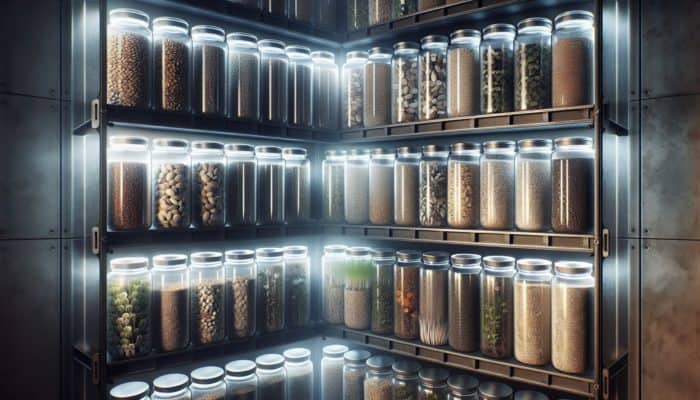Understanding the Critical Role of Survival Seed Vaults in Agriculture
Essential Reasons for Establishing Survival Seed Vaults

Survival Seed Vaults: Survival seed vaults play a crucial role in protecting the future of our agriculture, particularly in an era characterised by escalating environmental challenges and potential crises. These vaults serve as vital repositories for a diverse array of seed varieties, ensuring that a broad spectrum of plant genetics is preserved for the benefit of future generations. The significant advantages of survival seed vaults encompass:
- Preservation of Genetic Diversity: They store an extensive range of seed varieties, which are indispensable for adapting to evolving climatic conditions.
- Food Security: They serve as a contingency source of seeds to counteract crop failures or other unforeseen disasters.
- Research Opportunities: They provide essential resources for scientific investigations into plant genetics and agricultural practices.
- Disaster Preparedness: They act as a safety net against regional catastrophes, ensuring global accessibility to vital crops.
- Sustainable Agriculture: They encourage the use of heirloom and non-GMO seeds, thereby fostering biodiversity.
- Community Resilience: They empower local communities with the necessary tools to cultivate food sustainably.
The urgency for establishing survival seed vaults has never been greater. With unpredictable weather patterns, pest invasions, and socio-political instabilities endangering global food production, these vaults serve as a crucial safety net. They not only provide seeds but also build resilience by ensuring that various crops can be replanted, thereby supporting sustainable food systems.
Diverse Types of Seeds Stored in Survival Vaults
Survival seed vaults house a vast array of seed types, each chosen for its distinct characteristics and benefits. The primary categories encompass heirloom seeds, non-GMO seeds, and open-pollinated varieties.
Heirloom seeds are defined as plant varieties that have been cultivated and handed down through generations. They often possess remarkable flavour and nutritional value, contributing significantly to culinary diversity. Non-GMO seeds are cultivated without genetic modifications, appealing to those who favour organic or traditional farming methods. Open-pollinated seeds can breed true, meaning the seeds produced by these plants will maintain the same characteristics as the parent plants, making them a reliable choice for long-term cultivation.
Additionally, certain vaults focus on regional specialties, prioritising seeds that are particularly well-suited to local climates and agricultural practices. This diversity not only enriches global agriculture but also fortifies food systems by offering farmers varieties that are more adaptable to their specific environmental conditions.
Effective Preservation Techniques for Seeds
To guarantee seed viability over extended periods, survival seed vaults utilise various preservation techniques. One of the most prevalent methods is vacuum sealing, which eliminates air from the packaging to diminish oxidation and moisture levels that can compromise seed quality.
Desiccation is another vital technique. By reducing moisture levels in seeds, vaults can greatly extend their shelf life. Some facilities even employ cryopreservation, where seeds are frozen at ultra-low temperatures, effectively pausing metabolic processes and enabling seeds to remain viable for hundreds, even thousands, of years.
Maintaining optimal storage conditions is imperative. This involves regulating temperature, humidity, and exposure to light. For example, the Svalbard Global Seed Vault is situated deep within a mountain in Norway, where the naturally cold temperatures help preserve seeds. By employing these techniques, survival seed vaults ensure that seeds remain a reliable resource for future agricultural needs, irrespective of the challenges that may arise.
Global Distribution of Survival Seed Vaults

Survival seed vaults are strategically located worldwide to protect agricultural diversity from regional disasters while ensuring global accessibility. The most renowned of these is the Svalbard Global Seed Vault, located on an Arctic island in Norway. This facility houses millions of seeds from numerous countries, serving as a global insurance policy for agricultural biodiversity.
Other significant vaults include the Millennium Seed Bank in the UK, which concentrates on preserving wild plant species, and the Duke Farms Seed Bank in the United States, which focuses on safeguarding native plant varieties. Additionally, regional seed banks such as the USDA National Seed Storage Laboratory and the International Rice Genebank in the Philippines exist worldwide, each dedicated to specific crops and local agricultural requirements.
These vaults not only shield seeds from environmental catastrophes but also facilitate the sharing of genetic resources beyond borders. This collaborative approach is crucial for tackling global food security issues and fostering resilience in agriculture.
Addressing Challenges and Envisioning the Future of Seed Vaults
Despite their significance, seed vaults face numerous challenges in ensuring survival. One prominent issue is funding; maintaining these facilities necessitates considerable financial resources for storage, security, and ongoing research. As climate change escalates, vaults must also evolve to ensure their effectiveness, which requires innovative approaches to seed preservation.
Moreover, accessibility poses a challenge. While some seed vaults are accessible to researchers and specific organisations, navigating their retrieval processes can be complex and bureaucratic. To enhance effectiveness, international collaboration is essential. Organisations such as the Global Crop Diversity Trust strive to ensure that seed vaults are adequately funded and that their resources are accessible to those in need.
Looking ahead, the future of seed vaults appears promising, as continual research and technological advancements progressively enhance preservation techniques. By addressing these challenges through global cooperation, we can secure the efficacy and relevance of survival seed vaults in protecting our agricultural heritage.
Accessing and Utilising Survival Seed Vaults
Identifying the Locations of Survival Seed Vaults

Survival seed vaults can be accessed through various organisations committed to preserving seed diversity. These include agricultural research institutes, universities, and governmental initiatives focusing on food security and biodiversity conservation. Notable sources for identifying survival seed vaults include:
- Svalbard Global Seed Vault: Located in Norway, this is the world’s most renowned seed vault.
- Millennium Seed Bank: Based in the UK, it concentrates on protecting wild plant species.
- Duke Farms Seed Bank: Situated in the United States, it specializes in native plant varieties.
- USDA National Seed Storage Laboratory: Offers access to a diverse array of seeds in the United States.
Accessing these vaults typically necessitates collaboration with organisations dedicated to agricultural research or environmental conservation. Each vault may have different protocols and policies regarding seed access, often highlighting the importance of preserving genetic diversity for future generations.
Navigating the Process of Accessing a Survival Seed Vault
Accessing a survival seed vault generally involves a structured procedure. While each vault may have its guidelines, the following general steps can assist individuals or organisations in navigating the retrieval process effectively:
1. Identify the Vault: Ascertain which seed vault houses the specific seeds you require.
2. Registration: Complete any necessary registration or application forms required by the vault.
3. Approval Process: Await approval, which may involve a review of your intended use for the seeds.
4. Follow Retrieval Procedures: Adhere to the vault’s protocols for seed retrieval, ensuring you understand any conditions attached to seed use.
Each step may necessitate time and diligence, especially as vaults prioritise responsible access to their genetic resources. Familiarising yourself with these procedures can facilitate successful access and utilisation of vital agricultural seeds.
Successful Planting and Growing of Seeds from Vaults
Once you have procured seeds from a survival seed vault, knowing how to plant and cultivate them is crucial for successful growth. The initial step is germination, where seeds are prepared for planting. This process often involves soaking the seeds in water for a designated period, allowing them to absorb moisture and signaling to them that it is time to grow.
Following germination, it is imperative to select the appropriate planting medium. A healthy, well-draining soil mix is essential for supporting seedling growth. Seeds should be planted at the correct depth, typically around two to three times their diameter, depending on their size.
Once planted, diligent care and attention are paramount. This includes monitoring moisture levels, ensuring adequate sunlight, and protecting seedlings from pests and diseases. Regularly observing their growth and adjusting care routines as necessary will result in healthy plants that can flourish and produce future seeds, thereby contributing to the genetic diversity safeguarded in vaults.
Expert Insights into Survival Seed Vaults
Current Trends in Seed Vaulting Practices
The domain of seed vaulting is continuously evolving, with experts identifying several key trends that are shaping the future of seed preservation. One notable trend is the increasing emphasis on collaboration among global seed banks. Initiatives promoting the sharing of genetic material among vaults enhance global food security.
Technological advancements are also influencing seed vaulting practices. Innovations in genetic sequencing enable a deeper understanding of seed genetics, which can enhance breeding programmes and conservation strategies. Additionally, the adoption of automated climate control systems in vaults ensures that seeds are stored under optimal conditions, thereby prolonging their viability.
Another trend is the focus on community involvement, where local populations are engaged in seed preservation efforts. This grassroots approach not only helps maintain agricultural diversity but also empowers communities to take ownership of their food systems.
Real-world examples, such as the collaboration between the Svalbard Global Seed Vault and various agricultural organisations, demonstrate how interconnected efforts are pivotal in advancing the mission of seed preservation worldwide.
Assessing the Effectiveness of Seed Vaults
Experts evaluate the effectiveness of survival seed vaults using various criteria. One primary measure is seed viability, which gauges how well seeds can germinate after being stored for extended periods. Regular germination tests are conducted to ensure that seeds remain viable and can be successfully cultivated.
Another significant criterion is genetic diversity. Experts analyse the range of seed varieties stored in vaults to confirm that a broad spectrum of genetic resources is maintained. This diversity is crucial for adapting to changing environmental conditions and ensuring food availability.
Accessibility is also a critical factor. An effective seed vault should have transparent policies for seed access, allowing researchers and farmers to utilise these resources without excessive barriers. By evaluating these factors, experts can determine how well seed vaults fulfil their mission of preserving agricultural diversity and security.
Future Prospects and Innovations for Seed Vaults
The future of survival seed vaults appears promising, with experts anticipating several scenarios that underscore their role in global food security and biodiversity preservation. As climate change accelerates, the demand for diverse seed varieties that can withstand extreme weather conditions becomes increasingly urgent. Seed vaults will likely be instrumental in providing these essential genetic resources.
Furthermore, advancements in biotechnology and genetic engineering could introduce new methodologies for seed preservation and cultivation. Researchers are exploring strategies to enhance the viability of seeds stored in vaults, potentially extending their lifespan even further.
International cooperation and funding will also be critical in ensuring the long-term sustainability of seed vaults. With the growing recognition of their significance, more governments and organizations are expected to invest in these facilities, thereby enhancing their capabilities and outreach.
Overall, as we confront increasing agricultural challenges, survival seed vaults will remain central to ensuring that future generations have access to the diverse crops essential for sustainable food production.
Advantages of Survival Seed Vaults
How Survival Seed Vaults Contribute to Global Food Security
Survival seed vaults serve as a foundational element in ensuring global food security by safeguarding a wide variety of seeds that can be utilised for future planting. They act as a critical backup resource in situations of crop failures, natural disasters, or political instability. Here are several ways in which seed vaults bolster food security:
- Diverse Seed Varieties: They encompass numerous crop varieties, enabling farmers to select the most suitable seeds for their local conditions.
- Backup Source: During times of crisis, these vaults provide essential seeds that help restore agricultural systems.
- Research and Development: Seed vaults support agricultural research, enabling the creation of resilient crop strains.
- Long-Term Planning: They facilitate the preservation of seeds for future generations, ensuring ongoing food availability.
The importance of survival seed vaults in food security cannot be overstated. By protecting genetic diversity, they empower farmers and communities to adapt to changing conditions, ultimately contributing to a more resilient food system.
Preserving Genetic Diversity through Seed Vaults
Genetic diversity is vital for sustainable agriculture, and survival seed vaults are instrumental in preserving this diversity. By storing a vast range of seeds, these vaults help maintain the genetic variations necessary for crops to adapt to changing environmental conditions, such as climate change and emerging pests.
Each seed variety possesses unique traits, enabling crops to thrive in diverse climates and resist various diseases. The preservation of this genetic pool is crucial for breeding programmes aimed at developing new varieties that can thrive under adverse conditions. This genetic reservoir not only supports local agriculture but also contributes to global food security.
Furthermore, seed vaults promote the revival of endangered plant species, ensuring that traditional and indigenous crops are not lost to modernization and industrial agriculture. By safeguarding these varieties, survival seed vaults help maintain the agricultural heritage and cultural identities of communities worldwide.
The Integral Role of Seed Vaults in Disaster Preparedness
Survival seed vaults are a fundamental component of disaster preparedness strategies globally. They function as a safeguard against potential catastrophes that can disrupt food production, such as natural disasters, warfare, or pandemics. The availability of a dependable seed supply can be the difference between recovery and prolonged food scarcity.
Having access to a backup source of seeds enables communities to restore their agricultural systems following a disaster quickly. This access is particularly vital in regions prone to climate-related events, such as droughts or floods. By ensuring that diverse crops are available, seed vaults enhance food resilience and community recovery efforts.
Moreover, seed vaults can play a proactive role in educating communities about sustainable agricultural practices. By providing access to a diverse range of seeds, they help farmers diversify their crops, thereby reducing their reliance on a single variety. This diversification strategy is critical for building resilience against future shocks and securing long-term food security.
Contributing to Sustainable Agriculture with Seed Vaults
Survival seed vaults significantly contribute to sustainable agriculture by preserving heirloom and non-GMO seeds that promote biodiversity. These seeds often exhibit traits that make them well-suited to local environments and farming practices, enabling farmers to cultivate crops that are both resilient and environmentally friendly.
By storing a diverse array of seeds, these vaults encourage farmers to adopt traditional agricultural practices that promote soil health and balance the ecosystem. Furthermore, the preservation of heirloom varieties ensures that unique flavours and nutritional qualities are maintained, fostering a diverse and nutritious food supply.
Seed vaults also mitigate dependency on commercial seed varieties, which may be subject to market fluctuations and might not be suitable for all local conditions. By providing access to a range of seeds, vaults empower farmers to make informed decisions, ultimately supporting sustainable farming practices that benefit both people and the planet.
Economic Advantages of Seed Vaults for Communities
Survival seed vaults yield significant economic benefits for communities by ensuring local food production and promoting resilience during economic downturns. By providing access to diverse seed varieties, these vaults enable farmers to cultivate crops that are well-adapted to their local conditions, thereby reducing reliance on external food sources.
Having a local seed supply enhances food sovereignty, empowering communities to grow their food and establish local markets, thereby promoting self-sufficiency and resilience. This can lead to decreased food costs and increased economic stability, particularly in rural areas where agriculture is a central component of the local economy.
Moreover, the preservation of traditional crops can attract niche markets interested in heirloom varieties, providing farmers with new revenue streams. By investing in local food systems, communities can strengthen their economies while contributing to global efforts to conserve agricultural biodiversity.
Challenges and Solutions in Managing Survival Seed Vaults
Key Challenges in Seed Vault Management
Managing survival seed vaults presents a variety of challenges that must be addressed to ensure their effectiveness. Key challenges include:
- Seed Viability: Ensuring that seeds remain viable over extended storage periods necessitates constant monitoring.
- Storage Conditions: Maintaining optimal temperature and humidity levels is essential for preserving seeds.
- Access Management: Balancing accessibility with the need to protect genetic resources can complicate retrieval processes.
- Funding: Securing adequate financial resources for vault maintenance and operations is a persistent challenge.
These challenges require a proactive approach to seed vault management. By recognising and addressing these issues, vaults can enhance their effectiveness and contribute more significantly to global food security and biodiversity conservation.
Strategies for Overcoming Seed Vault Challenges
To effectively tackle the challenges faced by survival seed vaults, several strategies can be implemented. Regular monitoring of stored seeds is crucial to ensure their viability, with germination tests facilitating the early detection of any issues. Improved storage techniques, such as automated climate control systems, can help maintain ideal conditions for seed preservation.
Collaboration with experts in agriculture and seed science is also vital. By pooling knowledge and resources, vaults can enhance their management practices and devise innovative solutions to common challenges. This collaborative approach can facilitate research into new preservation technologies that could further prolong seed viability.
Finally, community involvement can play a substantial role in supporting seed vaults. Engaging local populations in preservation efforts not only raises awareness but also reinforces the importance of maintaining diverse agricultural resources for future generations.
Significance of Community Involvement in Seed Vaults
Community involvement is essential for the success and sustainability of survival seed vaults. Local populations often possess invaluable traditional knowledge about agriculture, which can greatly enhance the effectiveness of seed preservation efforts. By involving communities in the management of seed vaults, a sense of ownership and responsibility is fostered, ensuring that these resources are utilised sustainably.
Moreover, community engagement helps bridge the gap between scientific research and the practical needs of farming. Farmers can provide feedback on the types of seeds that are most beneficial to their local ecosystems, guiding vault management decisions. This collaborative approach can lead to more resilient agricultural systems that reflect the unique needs of each community.
Educational initiatives that raise awareness about the importance of genetic diversity and seed preservation can further enhance community involvement. When individuals understand the significance of these efforts, they are more likely to participate actively, ensuring that survival seed vaults fulfil their mission for generations to come.
Technological Innovations Enhancing Seed Vault Preservation
Technological advancements have remarkably improved the preservation and management of seeds in survival vaults. Automated climate control systems, for example, facilitate precise regulation of temperature and humidity levels, ensuring optimal storage conditions for seed viability. These systems mitigate the risk of human error and enhance the overall efficiency of vault operations.
Genetic sequencing technologies also play a pivotal role in seed vault management. By analysing the genetic makeup of stored seeds, researchers can better understand their potential for resilience and adaptability. This knowledge informs breeding programmes aimed at developing new varieties that can withstand climate challenges.
Moreover, data management software facilitates the tracking of seed inventories, enabling vault managers to monitor seed viability and access easily. As technology continues to evolve, survival seed vaults will benefit from innovations that enhance their capacity to preserve genetic diversity and support global food security.
Funding and Resource Management for Seed Vaults
Securing sufficient funding and resources is vital for the maintenance and expansion of survival seed vaults. Many vaults rely on a combination of governmental funding, private donations, and partnerships with non-governmental organisations to sustain their operations. Ensuring a steady influx of resources permits continued seed preservation and the implementation of innovative management practices.
In addition to securing funding, resource allocation must be strategic and effective. Prioritising investments in technology, infrastructure, and community engagement can enhance the effectiveness of seed vaults. Collaborations with universities and research institutions can also provide additional resources, expertise, and funding opportunities that support ongoing preservation efforts.
By fostering a culture of collaboration and investment in seed vaults, stakeholders can ensure that these vital resources remain sustainable and effective in safeguarding agricultural diversity for future generations.
Research-Backed Advantages of Survival Seed Vaults
Enhancing Agricultural Resilience through Seed Vaults
Research indicates that survival seed vaults significantly bolster agricultural resilience by providing access to a diverse pool of seeds that can adapt to changing conditions. By preserving a wide variety of genetic material, these vaults enable farmers to select crop varieties that are optimally suited to their local environments, thereby improving their chances of successful harvests.
Studies have shown that increased genetic diversity in crops is correlated with enhanced resistance to pests, diseases, and climatic fluctuations. This resilience is particularly critical as climate change continues to impact agricultural systems worldwide. Seed vaults serve as an indispensable resource for farmers aiming to adapt to these challenges, ensuring they possess the necessary tools to cultivate resilient crops.
Moreover, the availability of diverse seeds encourages experimentation and innovation in farming practices. Farmers can explore new varieties, helping them discover crops that not only perform well but also contribute to sustainable agricultural systems. In this manner, seed vaults play a vital role in promoting agricultural resilience and ensuring food security.
Impact of Seed Vaults on Crop Diversity
Survival seed vaults exert a profound influence on crop diversity, playing a significant role in maintaining and enhancing the variety of crops accessible to farmers globally. Research illustrates that preserving a wide array of seed types is crucial for promoting agricultural biodiversity, which is essential for sustainable farming practices.
By safeguarding heirloom seeds and other traditional varieties, vaults ensure that unique genetic traits are not lost to modern agricultural practices. This diversity is essential for developing crops that can thrive under diverse environmental conditions, as it provides farmers with options that are better suited to their specific needs.
Furthermore, seed vaults facilitate research into crop improvement and breeding programmes. By providing access to diverse genetic material, researchers can develop new varieties that are more resilient to climate change, pests, and diseases. This ongoing enhancement of crop diversity ultimately supports global food security and agricultural sustainability.
Long-Term Seed Viability in Vaults
Research has confirmed that seeds stored in survival seed vaults can maintain their viability for extended periods, thereby ensuring their availability for future use. Studies indicate that when stored under optimal conditions—such as low temperatures and low humidity—seeds can remain viable for decades or longer.
The longevity of seeds in vaults is essential for maintaining agricultural diversity and providing a reliable resource for future generations. This long-term preservation enables farmers to access a diverse range of crop varieties, thereby contributing to sustainable food production practices.
Moreover, ongoing research into seed viability continues to enhance our understanding of how to extend the life of stored seeds. By refining preservation techniques and exploring new storage methods, seed vaults can enhance their capacity to preserve genetic resources for an extended period, thereby reinforcing their crucial role in global agriculture.
Economic Advantages of Seed Vaults for Farmers
Survival seed vaults offer substantial economic benefits for farmers by providing access to a diverse array of seeds that can lower costs and enhance resilience. Farmers who can select from a variety of seed types are better equipped to respond to market fluctuations and changing environmental conditions.
By utilizing the genetic resources stored in seed vaults, farmers can cultivate crops that are better suited to their local climates, thereby improving their chances of achieving successful yields. This adaptability can lead to increased profitability and reduced dependency on commercial seed varieties that may be more expensive or less suitable for local conditions.
Research also suggests that access to diverse seed varieties can lead to more sustainable farming practices. By encouraging crop rotation and biodiversity, farmers can enhance soil health and minimise the need for chemical inputs, ultimately benefiting both their economic viability and the environment.
Proven Strategies for Effective Management of Survival Seed Vaults
Best Practices for Efficient Seed Vault Management
Experts recommend several best practices for managing survival seed vaults, which are vital for ensuring the long-term preservation of seeds. These practices include:
1. Regular Monitoring: Frequent checks of seed viability through germination tests help identify any potential issues early.
2. Optimal Storage Conditions: Maintaining precise temperature and humidity levels is essential for preserving seeds.
3. Secure Access Protocols: Implementing clear procedures for seed retrieval ensures that genetic resources are responsibly managed.
4. Documentation and Record-Keeping: Detailed records of seed varieties and storage conditions enable effective management and research.
By implementing these best practices, seed vault managers can enhance the effectiveness of their facilities and ensure that genetic resources remain accessible for future generations.
Building Collaborations with Experts and Organisations
Collaborating with experts and organisations in the field of seed preservation is essential for enhancing the effectiveness and reach of survival seed vaults. Partnerships can provide access to additional resources, expertise, and funding opportunities that bolster vault operations.
For instance, collaborations between seed banks and agricultural research institutions can lead to the development of innovative preservation techniques and improved seed management practices. These partnerships can also facilitate knowledge sharing, enabling vaults to stay up-to-date with the latest developments in seed science and preservation.
Real-world examples of successful collaborations include initiatives where seed vaults work with local farmers to identify valuable seed varieties that should be prioritised for preservation. By incorporating local knowledge and expertise, these collaborative efforts can ensure that vaults meet the needs of the communities they serve.
Raising Public Awareness on the Importance of Seed Vaults
Educating the public about the significance of survival seed vaults is vital for their long-term success and support. Raising awareness regarding the role of these vaults in preserving agricultural diversity and ensuring food security can foster public interest and involvement.
Outreach programmes that engage communities in discussions about seed preservation and its benefits can empower individuals to take action. Workshops, seminars, and educational campaigns can serve as effective tools for disseminating information and inspiring grassroots involvement.
Moreover, leveraging social media platforms to share success stories and highlight the impact of seed vaults can reach a broader audience. By cultivating a sense of community around the preservation of seeds, organisations can foster a culture of stewardship that supports the mission of survival seed vaults.
Frequently Asked Questions (FAQs)
What exactly are survival seed vaults?
Survival seed vaults are secure facilities designed to store seeds from a variety of plant species, preserving genetic material for future use to ensure food security and biodiversity.
Why are survival seed vaults crucial?
They are vital for preserving genetic diversity, supporting food security, and providing a backup source of seeds in case of crop failures or disasters.
How can I access seeds from a survival seed vault?
Accessing seeds typically involves identifying the vault, completing the registration process, and following the specific retrieval procedures established by the vault.
What types of seeds are typically stored in survival seed vaults?
Seed vaults generally store heirloom, non-GMO, and open-pollinated seeds, each offering unique advantages for agriculture and biodiversity.
In what ways do seed vaults contribute to disaster preparedness?
They provide a backup source of seeds that can be crucial for restoring agricultural production following natural disasters or other crises.
What challenges do survival seed vaults encounter?
Challenges include maintaining seed viability, optimal storage conditions, securing funding, and effectively managing access to stored seeds.
How can community involvement benefit seed banks or seed vaults?
Engaging communities in seed preservation efforts fosters a sense of ownership and ensures that vaults cater to local agricultural needs.
What technological innovations enhance seed vault preservation?
Advancements such as automated climate control systems and genetic sequencing technologies enhance seed storage conditions and strengthen preservation efforts.
What is the long-term viability of seeds in vaults?
Research indicates that seeds stored under optimal conditions can remain viable for decades, ensuring their availability for future agricultural use.
How do seed vaults support sustainable agriculture?
By preserving diverse heirloom and non-GMO seeds, they promote biodiversity and reduce reliance on commercial seed varieties, benefiting sustainable farming practices.
Explore our journey on X!
Edible Plant Safety: A Universal Guide
Understanding Edible Plant Safety: A Comprehensive Guide What Exactly Are Edible Plants? Edible Plant Safety: Edible plants encompass a diverse range of fruits, vegetables, herbs, and other plant parts that are safe for human consumption. Knowing what qualifies as an edible plant is crucial for ensuring safety, particularly for those interested in foraging or incorporating wild […]
Blizzard Food Storage: Essential Tips and Techniques
Essential Steps for Preparing for Blizzard Conditions Effective Strategies for Stocking Non-Perishable Foods Blizzard Food Storage: When preparing for a blizzard, it is vital to focus on stocking non-perishable foods to ensure you have adequate sustenance throughout the storm. Such items are not only convenient but also possess a long shelf life, making them ideal […]
Freeze-Dried Food Reviews: A Comprehensive Guide
Comprehensive Guide to Understanding Freeze-Dried Foods What Exactly Are Freeze-Dried Foods? Freeze-Dried Food Reviews: Freeze-dried foods represent an impressive culinary innovation aimed at maintaining the natural characteristics of fresh produce while significantly prolonging their shelf life. The freeze-drying process involves removing moisture from food, a technique that effectively preserves both nutritional value and flavor. This method […]
Food Preservation Tools: Essential Techniques and Equipment
Essential Tools for Preserving Food Effectively What Are the Key Tools for Food Preservation? Food Preservation Tools: Food preservation tools encompass a variety of essential devices and methods designed to extend the shelf life of food while ensuring its quality and safety. These tools range from basic kitchen implements to sophisticated technological systems. Whether you […]








Isn’t it wild to think of survival seed vaults as the planet’s backup plan? I mean, if we can save rare seeds, maybe we can also brainstorm how to save my indoor plants from my black thumb! It’s like a botanical insurance policy, only instead of premiums, we get to hoard those glorious heirloom tomatoes for a rainy day. Remember that infamous summer when everyone tried to grow their own veggies? To think a stash of hardy seeds could have saved us from the great zucchini apocalypse! Plus, it makes you wonder what kind of newer, tougher varieties we could come up with if scientists really get their hands dirty. What’s next, a seed vault for tacos? Now that’s some food security I can get behind! What new varieties do you think we could create to meet future challenges?